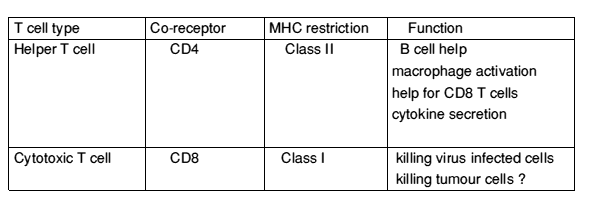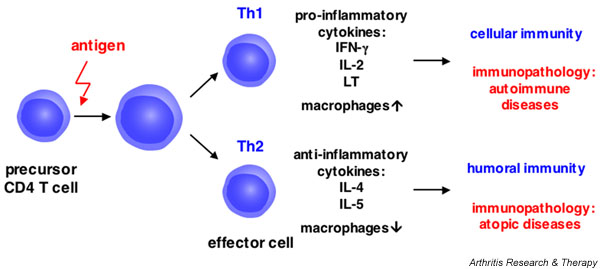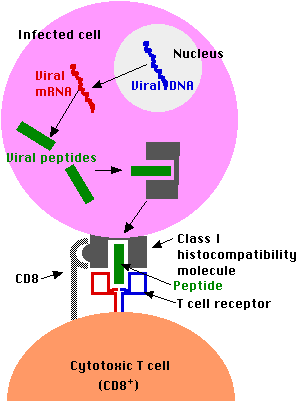*This web page was produced as an assignment for an undergraduate course at Davidson College.*
Cellular Immune Response
Regulation of HBV occurs through non-cytolytic downregulation of viral replication, which means that viral clearance results without killing the infected cells. Generally, this occurs through the release of cytokines by virus-inactivated lymphomononuclear cells (Rehermann and Nascimbeni, 2005). As a result, virus-specific CD8+ and CD4+ T cells play key effector and regulatory roles in hepatitis B antiviral immunity. Though CD8+ T cells are the main effector cells that cause viral clearance, CD4+ T cells are necessary to facilitate the induction and maintenance of CD8+ T cells (Guidotti and Chisari, 2006). The figure below shows the corecepter, MHC restriction, and function of each T cell type.

Figure 9. Image from http://www-immuno.path.cam.ac.uk/~immuno/part1/lec08/lec8_97.html
CD4+ T cell Response
Activated HBV-specific CD4+ T cells are multispecific. However, strong helper T cell responses are found against certain peptides in both the HBcAg and HBeAg following resolution of acute HBV infection. While HBeAg has been shown to induce a Th2 immune response, HBcAg stimulated a Th1 response. Additionally, CD4+ T cell responses are detected against polymerase and X antigens (Chang and Lewin, 2007). Because the Th2 response to HBeAg was dominant to the Th1 response to the HBcAg, the HBcAg-specific T cells were depleted in vivo (Huang et. al., 2006).
It is important that both Th1 and Th2 responses are generated because they induce different responses. While the Th1 cells stimulate macrophages, which can clear virus particles, the Th2 cells stimulate humoral immunity, in which B cells are stimulated to generate immunoglobulins for opsonization. However, different doses of virus seem to generate different responses. For example, low doses of virus produce a Th1-mediated response while high doses of virus produce a Th2-mediated response (Huang, et. al., 2006). The figure below shows a flow chart of CD4+ differentiation into both Th1 and Th2 cells and their functions.

Figure 10. Image from http://arthritis-research.com/content/figures/ar1703-2.jpg
CD8+ T cell Response
CD8+ T cells are the main effector cells in the viral clearance of HBV. Experiments that depleted CD8+ T cells in chimpanzees after infection with HBV resulted in viral persistence of HBV, indicating the importance of these cells. CD8+ T cells produce IFN-γ, which clear HBV through destabilization of the viral capsid, degradation of viral proteins, and post-transcriptional degradation of HBV RNA. The combined effect of cytokines, such as IFN- γ (which can also be produced by HBV specific Th1 CD4+ T cells), and cytolytic activity leads to the destruction of the virus without excessive liver damage (Chang and Lewin, 2007). Figure 11 below shows a CD8+ cell interacting with an infected cell.

Figure 11. Image from http://users.rcn.com/jkimball.ma.ultranet/BiologyPages/C/ClassIpath.gif
Chang, J.J. and Lewin, S.R. 2007. “Immunopathogenesis of hepatitis B virus infection.” Immunology and Cell Biology 85: 16-23.
Huang, C., Lin, S., Ho, Y., Chen, F., & Yang, C. 2006. The immune response induced by hepatitis B virus principal antigens. Cellular and Molecular Immunology 3(2): 97-106.
Guidotti, L.G. and Chisari, F.V. 2006. “Immunobiology and pathogenesis of viral hepatitis.” Annual Review of Pathology 1: 23-61.
Rehermann, B. and Nascimbeni, M. 2005. “Immunology of hepatitis B virus and hepatitis C virus infection.” Immunology 5: 215-229.
Return to Christie's Immunology Home Page
Christie Brough. Biology 307: Immunology. Dr. S. Sarafova. Davidson College. May 4, 2007.